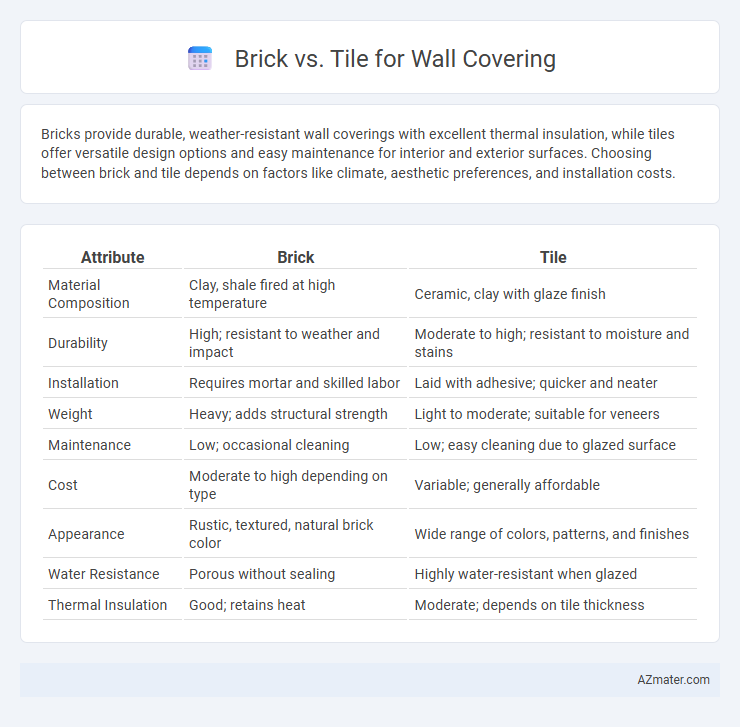Bricks provide durable, weather-resistant wall coverings with excellent thermal insulation, while tiles offer versatile design options and easy maintenance for interior and exterior surfaces. Choosing between brick and tile depends on factors like climate, aesthetic preferences, and installation costs.
Table of Comparison
| Attribute | Brick | Tile |
|---|---|---|
| Material Composition | Clay, shale fired at high temperature | Ceramic, clay with glaze finish |
| Durability | High; resistant to weather and impact | Moderate to high; resistant to moisture and stains |
| Installation | Requires mortar and skilled labor | Laid with adhesive; quicker and neater |
| Weight | Heavy; adds structural strength | Light to moderate; suitable for veneers |
| Maintenance | Low; occasional cleaning | Low; easy cleaning due to glazed surface |
| Cost | Moderate to high depending on type | Variable; generally affordable |
| Appearance | Rustic, textured, natural brick color | Wide range of colors, patterns, and finishes |
| Water Resistance | Porous without sealing | Highly water-resistant when glazed |
| Thermal Insulation | Good; retains heat | Moderate; depends on tile thickness |
Introduction to Wall Covering Options
Brick and tile represent two popular wall covering options, each offering distinct aesthetic and functional advantages. Brick provides a rustic, durable surface with excellent thermal insulation and a timeless appeal, ideal for both interior and exterior walls. Tile offers versatile design patterns, moisture resistance, and easy maintenance, making it suitable for kitchens, bathrooms, and accent walls.
Overview of Brick Wall Coverings
Brick wall coverings offer a durable and timeless aesthetic, known for their natural texture and rustic charm that enhances both interior and exterior spaces. These coverings provide excellent insulation properties and resistance to weather elements, making them suitable for a variety of architectural styles. Installation involves using full bricks, veneer bricks, or brick slips, which offer cost-effective alternatives while maintaining the authentic appearance of traditional brick walls.
Overview of Tile Wall Coverings
Tile wall coverings offer a versatile and durable option for both interior and exterior spaces, providing a wide range of styles, colors, and textures that enhance aesthetic appeal. These coverings are highly resistant to moisture, stains, and temperature changes, making them ideal for kitchens, bathrooms, and high-traffic areas. Ceramic, porcelain, and stone tiles are popular choices, each delivering unique benefits in terms of maintenance, longevity, and design flexibility compared to brick wall coverings.
Aesthetic Appeal: Brick vs Tile
Brick offers a rustic, textured aesthetic that adds warmth and character to interior and exterior walls, making it ideal for industrial or traditional design styles. Tile provides a sleek, polished look with diverse colors, patterns, and finishes, allowing for versatile customization in modern or contemporary spaces. The choice between brick and tile ultimately hinges on the desired ambiance, with brick promoting a timeless, earthy feel and tile delivering a clean, refined visual impact.
Durability and Longevity Comparison
Brick wall coverings offer exceptional durability, resisting impacts, weathering, and fire, making them ideal for long-term structural integrity. Tile wall coverings provide strong resistance to moisture, stains, and scratches, particularly in indoor and wet environments, but may be more susceptible to cracking under heavy impact. Over time, brick generally outperforms tile in longevity due to its robust composition and low maintenance requirements, sustaining aesthetic appeal and structural function for decades.
Installation Process and Complexity
Brick wall covering requires more labor-intensive installation, involving careful alignment, mortar application, and curing time, which increases complexity and duration. Tile installation offers greater precision with pre-sized units, faster application using adhesives, and easier handling of intricate patterns or repairs. Both methods demand skilled labor, but tile systems generally allow for quicker, more flexible installation with less structural preparation.
Cost Analysis: Brick vs Tile
Brick wall coverings typically involve higher initial costs due to material and labor expenses, averaging between $6 to $15 per square foot. In contrast, tile installation ranges from $5 to $12 per square foot, offering more budget-friendly options with a wide variety of designs. Maintenance costs for brick are generally lower over time due to durability, whereas tile may require more frequent repairs or replacements depending on the material quality.
Maintenance Requirements and Upkeep
Brick walls often require minimal maintenance due to their durability and resistance to damage, needing only occasional cleaning and mortar joint inspections for cracks or wear. Tile walls demand more frequent upkeep to prevent grout discoloration and mold growth, necessitating regular cleaning and periodic resealing of grout lines. Both materials benefit from timely repairs, but tile surfaces generally involve higher maintenance effort to retain appearance and functionality.
Environmental Impact and Sustainability
Brick wall coverings typically have a higher environmental impact due to energy-intensive manufacturing processes and the extraction of raw materials like clay. Tiles, especially those made from recycled materials or natural stone, tend to offer greater sustainability benefits with lower carbon footprints and longer lifespans. Choosing eco-friendly adhesives and installation methods further enhances the environmental advantages of tile wall coverings over brick.
Choosing the Right Option for Your Space
Brick offers a rustic, durable wall covering ideal for creating a textured, industrial aesthetic, while tile provides versatile design options with easy maintenance and moisture resistance, perfect for kitchens and bathrooms. Choosing the right option depends on factors like budget, space functionality, and desired visual impact; bricks suit living areas and accent walls, whereas tiles excel in wet or high-traffic zones. Consider thermal insulation, installation complexity, and long-term upkeep to select a wall covering that balances style and practicality for your specific environment.

Infographic: Brick vs Tile for Wall Covering
 azmater.com
azmater.com